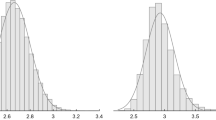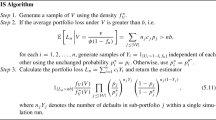Abstract
In this paper we study the tail risk of a properly diversified credit portfolio under a latent risk factor model. The usual perception is that if the diversification leads to asymptotic independence among the risk factors, then, because of the relatively low probability of simultaneous defaults, the tail risk of the entire portfolio is negligible. However, we point out that in fact there may be substantial tail risk hidden in this situation. We use a conditional tail probability of the portfolio loss to quantify the hidden tail risk, and then provide an asymptotic characterization for the risk under a hidden regular variation structure assumed for the risk factors. We also propose applications of the characterization to the determination and allocation of related insurance risk capital, based on the Conditional Tail Expectation risk measure. To understand the impact of dependence on the quantities of interest, we study two special cases where the risk factors have a Gaussian copula or an Archimedean copula. Numerical examples are provided to illustrate the results.





Similar content being viewed by others
Notes
See NAIC archived reports “Year-End 2014 Insurance Industry Investment Portfolio Asset Allocations” and “U.S. Insurance Industry Cash and Invested Assets at Year-End 2015” at http://www.naic.org/capital_markets_archive_index.htm.
If the stock price can be used as a proxy for the latent risk factor, then there has been empirical evidence showing that the risks of some technology firms and financial firms are asymptotically independent; see, e.g., [34].
See NAIC archived report “Analysis of the U.S. Insurance Industrys Exposure to Below-Investment Grade Investments” at http://www.naic.org/capital_markets_archive_index.htm.
References
Asimit AV, Furman E, Tang Q, Vernic R (2011) Asymptotics for risk capital allocations based on conditional tail expectation. Insur Math Econ 49:310–324
Asimit AV, Vernic R, Zitikis R (2013) Evaluating risk measures and capital allocations based on multi-losses driven by a heavy-tailed background risk: the multivariate Pareto-II model. Risks 1:14–33
Charpentier A, Segers J (2009) Tails of multivariate Archimedean copulas. J Multivar Anal 100:1521–1537
Coles S, Heffernan J, Tawn J (1999) Dependence measures for extreme value analyses. Extremes 2:339–365
Das B, Embrechts P, Fasen V (2013) Four theorems and a financial crisis. Int J Approx Reasoning 54:701–716
Das B, Mitra A, Resnick SI (2013) Living on the multidimensional edge: seeking hidden risks using regular variation. Adv Appl Probab 45:139–163
de Haan L, Ferreira A (2006) Extreme value theory: an introduction. Springer, New York
Denuit M, Kiriliouk A, Segers J (2015) Max-factor individual risk models with application to credit portfolios. Insur Math Econ 62:162–172
Dhaene J, Tsanakas A, Valdez EA, Vanduffel S (2012) Optimal capital allocation principles. J Risk Insur 79:1–28
Donnelly C, Embrechts P (2010) The devil is in the tails: actuarial mathematics and the subprime mortgage crisis. ASTIN Bull 40:1–33
Duffie D, Eckner A, Horel G, Saita L (2009) Frailty correlated default. J Financ 64:2089–2123
Embrechts P, Klüppelberg C, Mikosch T (1997) Modelling extremal events for insurance and finance. Springer, Berlin
Fougères A, Mercadier C (2012) Risk measures and multivariate extensions of Breiman’s theorem. J Appl Probab 49:364–384
Frees EW, Valdez EA (1998) Understanding relationships using copulas. N Am Actuar J 2:1–25
Frey R, McNeil AJ (2003) Dependent defaults in models of portfolio credit risk. J Risk 6:59–92
Furman E, Landsman Z (2005) Risk capital decomposition for a multivariate dependent gamma portfolio. Insur Math Econ 37:635–649
Furman E, Landsman Z (2008) Economic capital allocations for non-negative portfolios of dependent risks. ASTIN Bull 38:601–619
Furman E, Zitikis R (2008) Weighted risk capital allocations. Insur Math Econ 43:263–269
Gabaix X (2009) Power laws in economics and nance. Annu Rev Econ 1:255–293
Genest C, Nešlehová J (2007) A primer on copulas for count data. ASTIN Bull 37:475–515
Giesecke K (2004) Correlated default with incomplete information. J Bank Financ 28:1521–1545
Glasserman P, Li J (2005) Importance sampling for portfolio credit risk. Manag Sci 51:1643–1656
Gupton GM, Finger CC, Bhatia M (1997) CreditMetrics\(^{\rm TM}\)—technical document. Technical report. J. P. Morgan & Co., New York
Hao X, Li X (2015) Pricing credit default swaps with a random recovery rate by a double inverse Fourier transform. Insur Math Econ 65:103–110
Hashorva E (2005) Asymptotics and bounds for multivariate Gaussian tails. J Theor Probab 18:79–97
Hashorva E, Hüsler J (2002) On asymptotics of multivariate integrals with applications to records. Stochas Models 18:41–69
Hashorva E, Hüsler J (2003) On multivariate Gaussian tails. Ann Inst Stat Math 55:507–522
Heffernan JE (2000) A directory of coefficients of tail dependence. Extremes 3:279–290
Hua L, Joe H (2011) Tail order and intermediate tail dependence of multivariate copulas. J Multivar Anal 102:1454–1471
Hua L, Joe H, Li H (2014) Relations between hidden regular variation and tail order of copulas. J Appl Probab 51:37–57
Joe H (2015) Dependence modeling with copulas. CRC Press, Boca Raton, FL
Kim JHT, Hardy MR (2009) A capital allocation based on a solvency exchange option. Insur Math Econ 44:357–366
Kimberling CH (1974) A probabilistic interpretation of complete monotonicity. Aequ Math 10:152–164
Kiriliouk A, Segers J, Warchoł M (2015) Nonparametric estimation of extremal dependence. In: Dey DK, Yan J (eds) Extreme value modeling and risk analysis: methods and applications, Chapman & Hall/CRC, Boca Raton, FL, pp 367–389
Ledford AW, Tawn JA (1996) Statistics for near independence in multivariate extreme values. Biometrika 83:169–187
Ledford AW, Tawn JA (1997) Modelling dependence within joint tail regions. J R Stat Soc B 59:475–499
Manner H, Segers J (2011) Tails of correlation mixtures of elliptical copulas. Insur Math Econ 48:153–160
McNeil AJ, Frey R, Embrechts P (2015) Quantitative risk management. Princeton University Press, Princeton
McNeil AJ, Nešlehová J (2009) Multivariate Archimedean copulas, \(d\)-monotone functions and \(l_{1}\)-norm symmetric distributions. Ann Stat 37:3059–3097
Mitra A, Resnick SI (2011) Hidden regular variation and detection of hidden risks. Stochas Models 27:591–614
Malov SV (2001) On finite-dimensional Archimedean copulas. In: Balakrishnan N, Ibragimov IA, Nevzorov VB (eds), Asymptotic methods in probability and statistics with applications. Birkhäuser, Boston, MA, pp 19–35
Myers SC, Read Jr JA (2001) Capital allocation for insurance companies. J Risk Insur 68:545–580
Qi M, Zhao X (2011) Comparison of modeling methods for loss given default. J Bank Financ 35:2842–2855
Ratovomirija G (2016) On mixed Erlang reinsurance risk: aggregation, capital allocation and default risk. Eur Actuar J 6:149–175
Resnick SI (1987) Extreme values, regular variation, and point processes. Springer, New York
Resnick SI (2002) Hidden regular variation, second order regular variation and asymptotic independence. Extremes 5:303–336
Resnick SI (2007) Heavy-tail phenomena, probabilistic and statistical modeling. Springer, New York
Savage IR (1962) Mill’s ratio for multivariate normal distributions. J Res Natl Bureau Stand Sect B Math Sci 66:93–96
Scherer M, Schmid L, Schmidt T (2012) Shot-noise driven multivariate default models. Eur Actuar J 2:161–186
Scott A, Metzler A (2015) A general importance sampling algorithm for estimating portfolio loss probabilities in linear factor models. Insur Math Econ 64:279–293
Shi X, Tang Q, Yuan Z (2017) A limit distribution of credit portfolio losses with low default probabilities. Insur Math Econ 73:156–167
Tang Q, Yuan Z (2013) Asymptotic analysis of the loss given default in the presence of multivariate regular variation. N Am Actuar J 17:253–271
Tankov P (2016) Tails of weakly dependent random vectors. J Multivar Anal 145:73–86
Wang R, Peng L, Yang J (2015) CreditRisk+ model with dependent risk factors. N Am Actuar J 19:24–40
Wei L, Yuan Z (2016) The loss given default of a low-default portfolio with weak contagion. Insur Math Econ 66:113–123
Author information
Authors and Affiliations
Corresponding author
Rights and permissions
About this article
Cite this article
Yuan, Z. An asymptotic characterization of hidden tail credit risk with actuarial applications. Eur. Actuar. J. 7, 165–192 (2017). https://doi.org/10.1007/s13385-017-0150-6
Received:
Revised:
Accepted:
Published:
Issue Date:
DOI: https://doi.org/10.1007/s13385-017-0150-6




